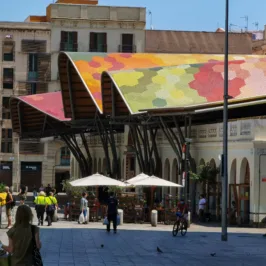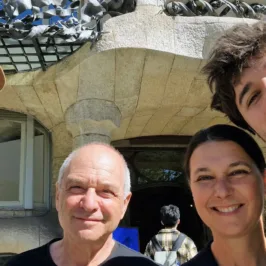Sant Antoni Market reopened after a nine-year restoration works.
The return of Sant Antoni Market a 135-year-old market is part of a citywide plan to revive local communities. Thousands of residents of the traditionally working class Barcelona neighbourhood of Sant Antoni thronged their local market last week as it reopened after a nine-year restoration works.
Barcelona’s barris, or neighbourhoods, revolve around their markets. There are 39 food markets in the city and no one is more than a 10-minute walk away.

“The market generates business, it’s a point of attraction but it’s also a social nexus,” explains Agustí Colom, head of commerce on the city council and the man charged with implementing Barcelona’s costly citywide market renovation plan. “People don’t just shop, they talk and they feel part of a community. We run programs in markets for elderly people who feel isolated. Because they’re regular customers, there are people there who know them and to whom they can talk about their problems.”
Sant Antoni actually consists of three markets. As well as a food area with 52 stalls, there are 95 stalls in the Encants (enchantments), the lightly ironic Catalan term for a flea market. In this case it mainly sells cheap clothes. On Sundays, Sant Antoni also hosts one of Europe’s largest open-air book markets, with 78 stalls selling new and secondhand books, comics, stamps and other collectables.
The market’s move to a temporary structure nearby lasted longer than expected as excavations for an underground car park uncovered part of the ancient city wall, as well as a stretch of the Roman Via Augusta that runs from the Pyrenees all the way to Cádiz in southwest. There were inevitable delays after the archaeologists were called in and the architects, Pere Joan Ravetllat and Carme Ribas, were obliged to rethink the design.
All but four of Barcelona’s 39 markets have had a makeover, with Sant Antoni the most expensive. The Mercat de Santa Caterina, which was rebuilt by Enric Miralles, architect of the Scottish parliament building, ran over budget when work unearthed a 12th-century convent and a Roman necropolis.

So what drove the city to invest tens of millions in refurbishing its markets?
“Spending on markets is probably one of the investments with the biggest return, both economically and socially,” says Colom. “This network of markets gives us a city that is structured much better than most.”
One notable feature of the refurbished markets is that each includes a small supermarket. While the rent they pay helps the city to recoup its investment, Colom insists that the supermarkets are not in competition with the stallholders. “A supermarket attracts more people to the market and they shop in both,” he says.
As people begin to care more about fresh food and its carbon footprint, the markets are becoming more attractive, he says, and since the citywide refurbishments began the number of people shopping in them has risen. The city has also initiated a “green market” campaign to encourage stallholders to prioritise local produce.

Sant Antoni was the first market to be built outside the city’s medieval walls. It was initiated by Ildefons Cerdà, the architect responsible for the Eixample, the grid system of streets that extended Barcelona beyond the Old City. In common with several other markets in the city it took advantage of the novel technique of erecting steel-framed buildings.
It opened in 1882 and by the time it closed in 2009 it had become a gloomy warren of stalls and bars. “Now everything is new and works a lot better,” says Escofet. “But costs are higher, we have to pay for cleaning and parking and the air conditioning is more expensive because the price of electricity has shot up.”
Colom points out that the €80m price tag includes both the cost of the temporary market and, more importantly, the creation of the city’s second “super block”– covering a 26,000 square metre area surrounding the market. The blocks are designed to “bring life to the street” by prioritising pedestrians over cars, with newly planted trees and children’s play areas.
The Sant Antoni neighbourhood, once reminiscent of one of the poorer Paris arrondissements, is undergoing a process of gentrification. Rents are rising and some of the city’s must upmarket restaurants have moved in. And then there are the tourists.

Some fear the revamped market will follow the city’s famous Boqueria, now so overwhelmed by tourists photographing the food that it’s effectively a no-go zone for residents.
Part of the problem is that the city, while investing in the markets for its citizens, also promotes them as tourist destinations. Colom insists that what the city and the stallholders want is for Sant Antoni to be for local people.
“The Boqueria is next to the Rambla,” says Escofet, referring to Barcelona’s iconic and tourist-plagued pedestrian thoroughfare. “This is not the same situation. There’s more tourism here than before because there are more tourist apartments, but this is a family market.”
Colom says they have reduced the number of bars in the market from 10 to three and tourist-oriented outlets will be discouraged.
For now, everyone in Sant Antoni seems happy to have their market back. As fruit stallholder Miquel Parra puts it: “The market brings life to everything.”









Leave a Reply